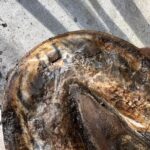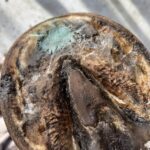- New Zealand
Bluestone Bang for Hoof Abscesses and Defects
- General Interest
-
Jun 30
- Share post

Kindly reproduced with permission from Vet Post
Hoof abscesses are a very common cause of sudden, severe lameness in horses encountered by veterinarians and farriers. These painful and often frustrating conditions occur when bacteria invade the sensitive tissues within the hoof, leading to localized infection and subsequent inflammation.
Causes of Hoof Abscesses:
Hoof abscesses typically develop as a result of bacteria entering the hoof through a compromised area, such as a small puncture or crack in the hoof wall. The following factors can contribute to the formation of hoof abscesses:
- Moisture and Mud: Prolonged exposure to wet and muddy conditions can soften the hooves, making them more susceptible to bacterial invasion
- Poor Hoof Care: Neglecting regular trimming and maintenance of the hooves can lead to cracks and overgrown areas, providing an entry point for bacteria.
- Foreign Objects: Sharp objects like nails, stones, or thorns can penetrate the hoof, causing injury and bacterial contamination. Even just being on a surface of gravel or sand for prolonged periods can cause fissures and allow bacteria to get into deeper parts of the hoof structure
- Thrush: An existing thrush infection can weaken the hoof structure, making it more vulnerable to abscess formation.
Symptoms of Hoof Abscesses:
Identifying hoof abscesses early is crucial for prompt treatment. Look out for the following signs that may indicate the presence of an abscess:
- Lameness: Horses with hoof abscesses often exhibit sudden and severe lameness, typically pronounced when weight is placed on the affected limb.
- Heat and Pain: The hoof may feel warm to the touch due to inflammation, and the horse may display signs of pain when pressure is applied to the affected area.
- Increased Digital Pulse: The digital pulse, felt at the back of the fetlock, may become stronger than usual due to the inflammation caused by the abscess.
- Swelling and Sensitivity: The hoof may show signs of swelling, and the horse may exhibit sensitivity when the hoof is picked up, tapped, or squeezed.
Treatment of Hoof Abscesses:
Resolving a hoof abscess generally involves a visit from your farrier or veterinarian – however there are steps you can take first
- Soaking and Poulticing: Soaking the hoof in warm water or an Epsom salt solution can help draw out the infection – start with 15-20 minutes morning and evening, followed by a poultice bandage and boot. A recommended combination of animalintex poultice, cohesive bandage, askina plast and a Tubbease Boot
- If you have no luck with the above after a day or two, then you need to get your veterinarian or farrier to examine the affected hoof
- Drainage: Once the abscess is located, your veterinarian or farrier may need to create a small drainage hole to release the accumulated pus and relieve pressure.
- Soaking and Poulticing: Continue to soak the hoof and poultice for a few days until the poultice comes out clean (inside) and there is no further purulent material present
- Farrier Care: Once the abscess has drained and the infection is under control, your farrier may need to trim and balance the hoof to promote proper healing and prevent future abscesses.
- Bluestone Bang: This is a semi permanent malleable wax to help seal and stabilise the hoof abscess cavity after the initial infection is drained.
The example below is of an abscess that had been drained, cleaned, dried and the Bluestone Bang wax applied


Preventing hoof abscesses is always better than treating them. Consider the following preventive measures:
- Regular Hoof Maintenance: Ensure your horse receives regular farrier care, including routine trimming, balancing, and maintaining a healthy hoof wall.
- Clean and Dry Living Conditions: Minimize exposure to wet and muddy environments, especially in high-risk seasons, and provide clean and dry bedding in stables and paddocks. This of course is extremely difficult in the current NZ conditions. However even just getting them out on a daily basis onto a dry area, cleaning the feet well and keeping on top of things will help. For those softer hooves we have the Keratex Hoof Hardener, and then for general maintenance and thrush prevention we have the Life Data Farrier’s Finish
- Prompt Wound Care: Thoroughly clean and treat any wounds or punctures on the hoof immediately to prevent bacterial entry.
Thanks again to Vetpost for letting us reproduce this article. Go and check them out at www.vetpost.co.nz
Comments
Add a comment
Leave a Reply · Cancel reply
You must be logged in to post a comment.
